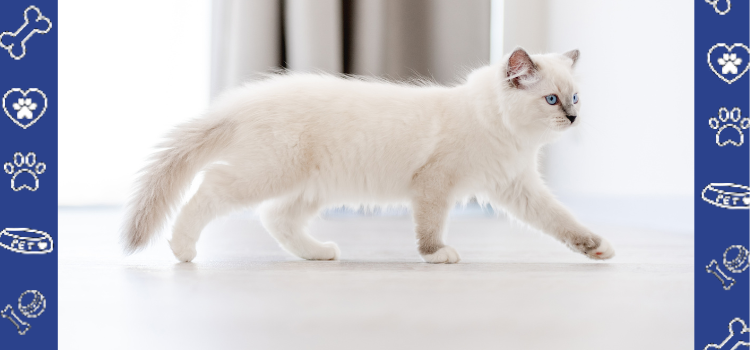Dealing with Cat Aggression: C...

Dealing with Cat Aggression: Causes and Solutions, and How PetCerts.com Can Help with ESA/PSD Housing Letters
Cats are known for their independence, but this doesn't mean they are free from emotional or behavioral issues. One common issue that pet owners face is cat aggression. Whether it’s aggression towards other pets, humans, or even objects, understanding its causes and finding solutions is essential for ensuring a harmonious household.
In this post, we’ll dive into the reasons why cats can become aggressive and offer strategies for managing this behavior. We’ll also explore how a letter from PetCerts.com for Emotional Support Animals (ESA) or Psychiatric Service Dogs (PSD) can play a crucial role in supporting individuals with emotional or psychological needs in housing situations.
Understanding the Causes of Cat Aggression
Aggression in cats can manifest in several ways, from hissing and scratching to biting and chasing. Understanding the root cause of this behavior is key to addressing it effectively. Below are some of the most common causes of cat aggression:
1. Fear or Anxiety
One of the most common causes of aggression in cats is fear. When a cat feels threatened, it may react aggressively as a defense mechanism. This can be triggered by unfamiliar people, loud noises, or changes in the environment. For example, moving to a new home, introducing a new pet, or even rearranging furniture can cause stress, leading to aggressive behaviors.
2. Territorial Behavior
Cats are naturally territorial creatures. If another animal or person enters their perceived territory, they may exhibit aggressive behavior to protect their space. This is particularly common when there are multiple pets in the home or if a new pet is introduced without proper introductions and gradual acclimation.
3. Pain or Illness
Sometimes, aggression in cats is a symptom of physical discomfort or illness. If a cat is in pain from an injury or an underlying health issue, it may lash out as a way of communicating distress. Conditions such as arthritis, dental issues, or infections can make a normally calm cat behave aggressively. It’s essential to consult a veterinarian if you notice sudden changes in your cat’s behavior.
4. Frustration or Redirected Aggression
Frustration can also lead to aggression in cats. For example, if a cat is unable to reach something it desires, such as food or a toy, it may become frustrated and take it out on the nearest person or animal. This type of aggression is known as redirected aggression.
Solutions for Managing Cat Aggression
Once you’ve identified the cause of your cat’s aggression, you can take steps to manage the behavior. Here are some strategies to help:
1. Provide a Safe Space
If your cat’s aggression is rooted in fear or territorial behavior, it’s important to create a safe space where they can retreat when feeling threatened. This could be a quiet room with their food, water, and litter box. Make sure the space is free from disturbances and allows the cat to feel secure.
2. Gradual Introductions
If you’ve introduced a new pet or person into the household, be sure to allow for a slow and controlled introduction. Allow your cat to observe the new addition from a distance before any direct interaction. This can reduce anxiety and prevent aggressive outbursts.
3. Regular Playtime and Enrichment
Frustration can often be alleviated by providing your cat with adequate mental and physical stimulation. Interactive play sessions, puzzle feeders, and scratching posts can help redirect energy in a positive direction.
4. Consult a Veterinarian
If you suspect that your cat’s aggression is due to pain or illness, a visit to the veterinarian is essential. A health check-up can help rule out any underlying medical issues that might be causing discomfort.
5. Behavioral Therapy
For cats with persistent aggression issues, seeking the help of a professional animal behaviorist can be a good option. They can provide specific training techniques and behavioral modification plans to address your cat’s aggression.
How PetCerts.com Can Help with ESA/PSD Housing Letters
If your cat's behavior is related to a deeper emotional or psychological need, such as anxiety or depression, it may be considered an Emotional Support Animal (ESA) or Psychiatric Service Animal (PSD). An ESA or PSD can help provide therapeutic benefits to individuals struggling with mental health conditions, offering comfort, companionship, and a sense of security.
When living in a housing situation, individuals with ESAs or PSDs have legal protections under the Fair Housing Act (FHA). This ensures that landlords cannot discriminate against tenants with emotional support or service animals, even in no-pet housing. However, to ensure your pet qualifies as an ESA or PSD, you'll need appropriate documentation.
PetCerts.com provides professional assistance in obtaining the necessary ESA or PSD Housing Letter. This letter serves as official documentation stating that your animal provides emotional or psychological support, making it easier for you to keep your pet in a rental property. Whether you’re struggling with anxiety, depression, or another condition, PetCerts.com can help you navigate the process of securing your ESA or PSD housing rights.
Dealing with cat aggression can be challenging, but understanding its causes and implementing effective solutions can help restore peace in your home. Whether it's providing a safe space, gradual introductions, or seeking professional help, there are many ways to address the issue.
Additionally, if your cat serves as an Emotional Support Animal or Psychiatric Service Animal, PetCerts.com can assist with the necessary documentation to help you maintain your living arrangements. With the right support, both you and your cat can enjoy a calmer and more fulfilling life together.
If you’re considering the benefits of having an ESA or PSD, reach out to PetCerts.com to learn more about how they can assist with your housing situation today!